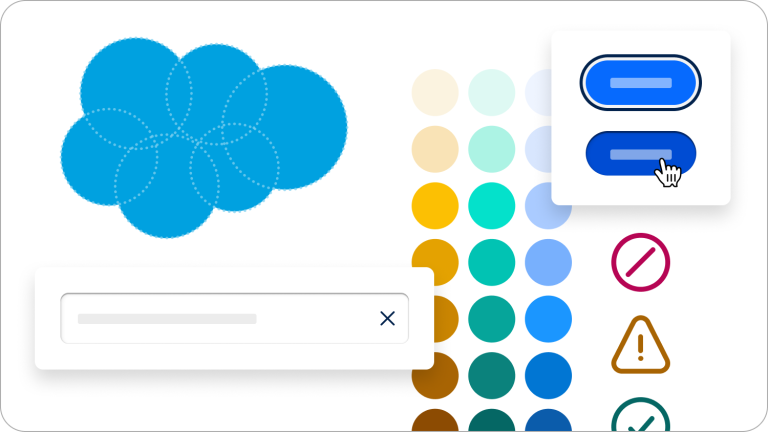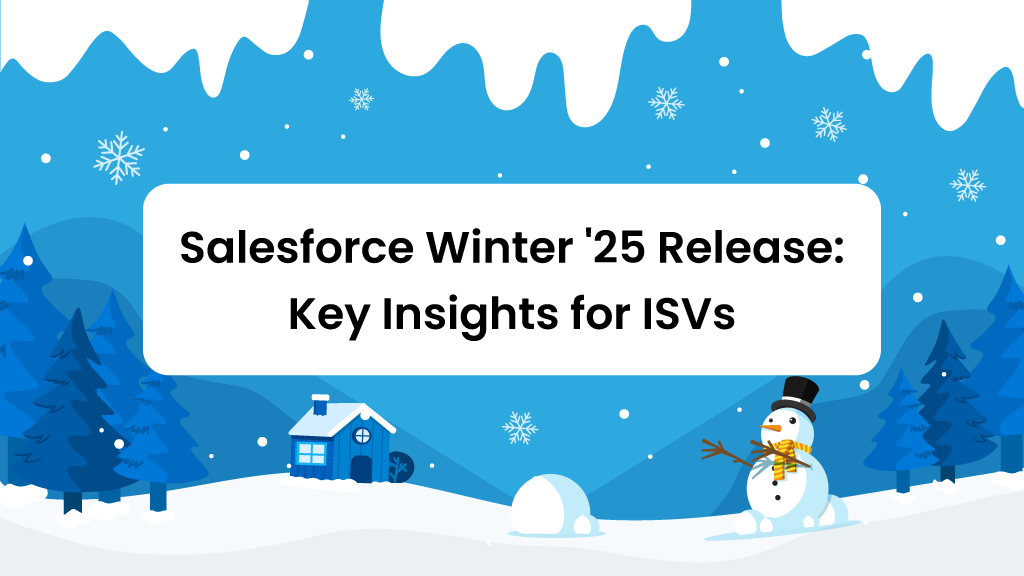Salesforce Winter ’25 release introduces significant updates and improvements aimed at enhancing platform performance, packaging options, and operational flexibility. ISVs, PDO partners, and Salesforce developers must prepare for these changes to align with evolving standards and seize new growth opportunities. This blog dives into the most impactful features, offering actionable insights and best practices for Salesforce ISVs.
1. Data Cloud Packaging – Simplifying Metadata Management for Multi-Org Deployments
Feature Overview:
The Salesforce Winter ’25 release requires separating Data Cloud metadata from non-Data Cloud metadata into distinct packages using Second Generation Packaging (2GP). The reason behind this change lies in the way Salesforce organizes Data Cloud objects. These objects operate within multiple namespaces—including a data space prefix and a package namespace—making it necessary to deploy them to the correct org and data space.
Why It Matters:
Previously, metadata packaging could lead to conflicts during multi-org deployments, especially when Salesforce Data Cloud components were mixed with standard Salesforce objects. With the new packaging rules, ISVs can avoid installation failures by designating specific data spaces for their packages.
What ISVs Should Do:
- Separate your metadata: Create one package exclusively for Data Cloud metadata and another for non-Data Cloud components.
- Use the 2GP framework: Ensure smooth installations across multiple orgs by utilizing 2GP capabilities for version control and upgrades.
- Plan ahead: Test new packages in sandbox environments to identify potential issues.
2. Agentforce Topics – A New Way to Tailor Salesforce Copilot’s Automation

Feature Overview:
The Agentforce Topics feature in Winter ’25 allows developers to group tasks into focused job categories, helping Copilot-powered solutions perform actions relevant to a specific task. These “topics” define the scope of actions the reasoning engine can consider, improving efficiency by narrowing down choices to those most appropriate for the task at hand.
Why It Matters:
The key advantage of Topics is that it enhances automation relevance and decision-making speed. By packaging actions under well-defined topics, Copilot can skip unnecessary steps, improving the user experience for complex workflows. For example, an ISV offering a case management solution could use Topics to limit actions only to those relevant for customer service agents.
What ISVs Should Do:
- Identify specific use cases within your solutions that can benefit from Agentforce Topics.
- Begin planning to package Topics into your product offerings to align with the November 2024 release.
- Test Copilot behavior using these topics to ensure a seamless experience for end-users.
3. Salesforce Foundations – Unlocking Growth Opportunities with Free Platform Features

Feature Overview:
Salesforce Foundations is a suite of free Sales, Service, Marketing, Commerce, and Salesforce Data Cloud features now available to Enterprise Edition customers at no additional cost. This offering provides users with extended trials of partner apps, giving them exposure to new solutions and encouraging product adoption.
Why It Matters:
For ISVs, Salesforce Foundations opens the door to new customer segments. With Salesforce promoting its Foundations package across various clouds, Salesforce ISVs can expand their reach by offering free trials or starter packages. This initiative lowers the entry barrier for new customers and introduces them to a broader range of Salesforce features.
What ISVs Should Do:
- Ensure your product is listed with AppExchange Launch Partners to take advantage of the extended trials Salesforce offers.
- Develop tailored offers or free trials that cater to Foundations users, helping them explore your product’s potential.
- Collaborate with Salesforce Partner Account Managers to align your go-to-market strategy with Salesforce’s Foundations framework.
4. Enhanced Lightning UI – Ensuring Compatibility and User Experience Excellence

Feature Overview:
Salesforce is rolling out an Enhanced Lightning UI across Service Cloud Professional and Enterprise Editions to provide a more consistent and responsive interface. This new UI improves navigation, layout, and overall usability, ensuring a smoother user experience.
Why It Matters:
Changes to the Lightning UI can impact the performance and usability of existing ISV solutions. If your app’s interface isn’t optimized for the new UI, you risk causing friction for your customers, leading to potential adoption challenges.
What ISVs Should Do:
- Audit your current UI: Ensure your app complies with the latest Lightning UI best practices to deliver an intuitive user experience.
- Use SLDS guidelines: Follow Salesforce Lightning Design System (SLDS) recommendations to align your app’s design with Salesforce’s evolving standards.
- Test in sandbox environments: Identify and address any UI inconsistencies before the new interface rolls out.
5. Marketing Cloud Growth Edition – Unlocking New Marketing Potential for SMBs

Feature Overview:
The Salesforce Winter ’25 release introduces Marketing Cloud Growth Edition on the Core Platform, targeting small and medium-sized businesses (SMBs). This version of Marketing Cloud offers features previously available only to larger enterprises, empowering SMBs with enhanced marketing capabilities.
Why It Matters:
For Salesforce ISVs, this new edition provides an opportunity to expand existing solutions into the marketing space. The Growth Edition offers standard packaging, three yearly upgrades, and seamless integration with the Core Platform, making it an ideal addition to ISV offerings focused on SMBs.
What ISVs Should Do:
- Develop SMB-focused marketing solutions that align with the Growth Edition’s capabilities.
- Prepare for three upgrade cycles per year to maintain compatibility with Salesforce’s evolving platform.
- Market your product as an all-in-one solution that supports both CRM and marketing needs.
6. Salesforce Platform Login License – A More Flexible Access Model

Feature Overview:
The Platform Login License is a new usage-based pricing option designed for users who need occasional access to custom apps and AI assistants. Instead of paying for a fixed number of users, businesses can now allocate seats dynamically based on actual usage.
Why It Matters:
This new license model provides Salesforce ISVs with more flexibility in pricing and user management. Apps designed for sporadic access—like compliance tools or reporting dashboards—can now be offered at a lower cost without sacrificing functionality.
What ISVs Should Do:
- Review your pricing models to align with the new Platform Login License.
- Monitor seat utilization to ensure efficient allocation of resources.
- Consider offering seat-based bundles to appeal to cost-conscious customers.
7. Financial Services Cloud on Core – Adapting to New Deployment Models
Feature Overview:
Financial Services Cloud (FSC) is now available directly on the core Salesforce platform, providing customers with two deployment options: core or managed package. This change introduces new data models and functionality that ISVs need to account for to maintain compatibility.
Why It Matters:
The core version offers enhanced flexibility but may require updates to existing ISV solutions that rely on the managed package. Ensuring compatibility across both versions will be crucial to providing seamless service.
What ISVs Should Do:
- Test your solutions with both core and managed versions of FSC.
- Update your apps to support the new data models, including financial accounts and roll-up summaries.
- Attend Salesforce’s FSC webinars to stay informed about architectural changes.
Partner with CEPTES to Stay Ahead
Navigating Salesforce Winter ’25 release requires not only technical know-how but also strategic planning. CEPTES, a Skasoft company, specializes in helping ISVs succeed on the Salesforce AppExchange by providing end-to-end support—from product design, development, and publishing to ongoing success management.
Our expert consultants focus on industrialized software development, release readiness, and product lifecycle management to ensure your solutions are optimized for every Salesforce release. Whether you need help with launch consulting services or fine-tuning your pricing strategy, CEPTES is here to guide you every step of the way.
Ready to unlock the full potential of Salesforce’s latest innovations? Connect with us and let’s explore how we can accelerate your product journey on the AppExchange.

Nilamani Das
Nilamani is a thought leader who champions the integration of AI, Data, CRM and Trust to craft impactful marketing strategies. He carries 25+ years of expertise in the technology industry with expertise in Go-to-Market Strategy, Marketing, Digital Transformation, Vision Development and Business Innovation.


















